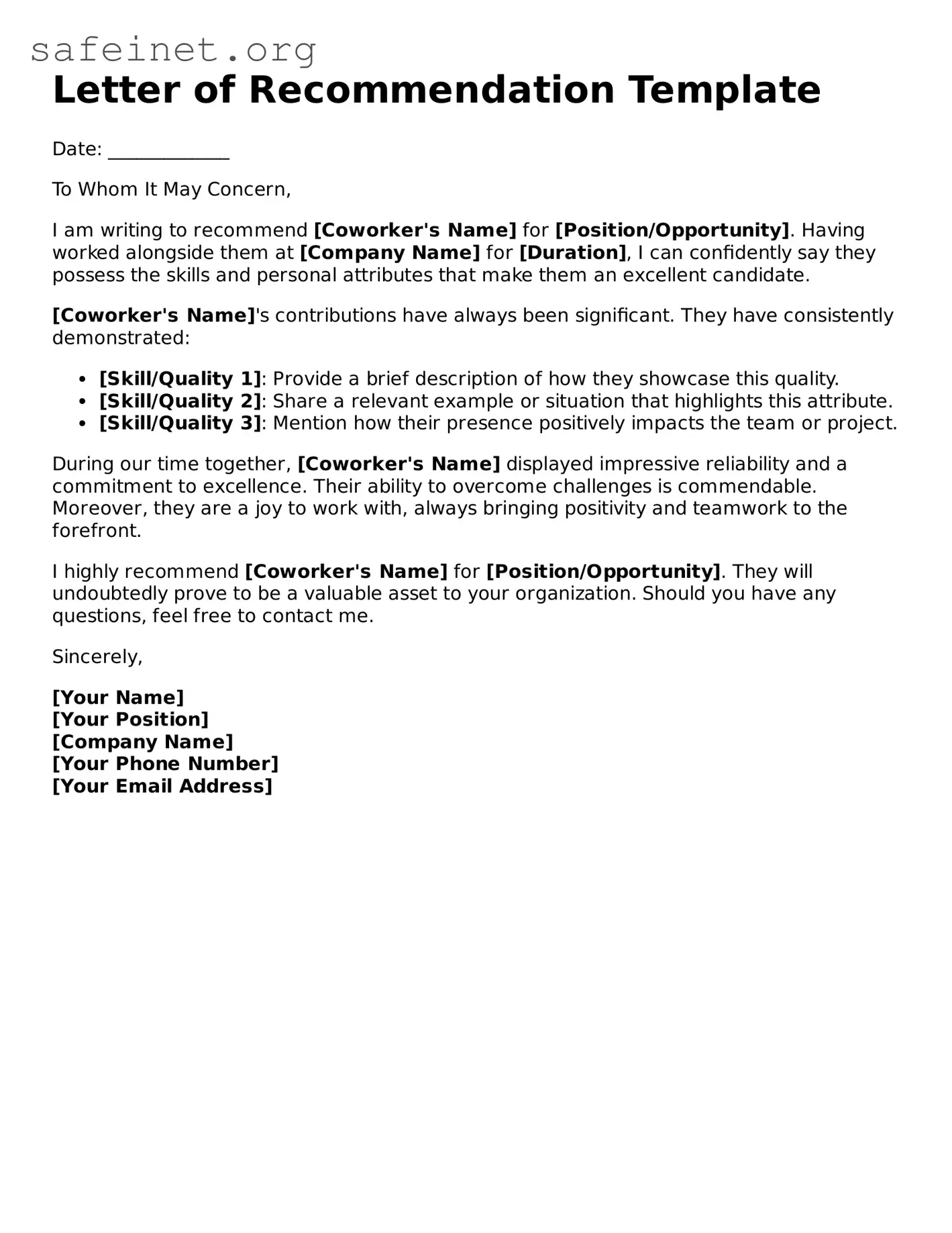The Letter of Recommendation for Coworker form bears similarities to the more widely recognized Letter of Recommendation form used by educational institutions. This document typically highlights a student's academic achievements and character traits. Just as the Coworker Letter emphasizes professional skills and contributions to a team, the educational letter focuses on a student's strengths and potential for future success. Both documents aim to provide a credible endorsement from a reliable source, whether it be a colleague or a teacher, thereby enhancing the recipient's chances of achieving their goals.
An additional document that aligns with the Coworker Letter is the Performance Evaluation. This internal HR document assesses an employee’s work performance over a defined period. Like the Letter of Recommendation, the Performance Evaluation summarizes skills, accomplishments, and areas for improvement. However, unlike the more subjective nature of a recommendation letter, this evaluation is typically grounded in specific metrics and feedback from managers, adding a layer of formal assessment.
The Reference Letter serves a purpose similar to that of the Coworker Letter but specifically pertains to personal or professional character. These letters are often requested by job applicants seeking to provide potential employers with external validation of their qualities. Like the Letter of Recommendation for Coworker, reference letters offer insights into the person’s work ethic, reliability, and interpersonal skills, further supporting the individual’s case for employment.
The Letter of Recommendation for Graduate School also mirrors the Coworker Letter, though it is geared toward academic pursuits. Faculty members often write these letters to advocate for a student's admission into advanced studies. Both types of letters share a common goal: they aim to highlight the capabilities and readiness of an individual for the next stage of their professional or academic journey, while tailoring the content to the intended context.
The Character Reference Letter provides a lens into the personal attributes of an individual, much like the Letter of Recommendation for Coworker. However, it often focuses on non-professional interactions and assesses qualities such as integrity, kindness, and leadership in a more casual context. Both letters serve to validate a person’s character, whether in a workplace setting or a community engagement setting, and reinforce the belief in the individual's integrity and value.
A nomination letter for awards or recognition shares a similarity with the Coworker Letter. It advocates for a colleague’s accolades within an organization. Both documents celebrate achievements and the positive impact an individual has made. They build a compelling narrative that not only reflects the individual's contributions but also frames them in a way that inspires others or persuades decision-makers to recognize the recipient’s value.
The Cover Letter, while serving a different function, parallels the Letter of Recommendation for Coworker in its persuasive nature. Job seekers craft cover letters to outline their skills and experiences to potential employers, similar to how recommendation letters summarize a coworker’s professional attributes. Both documents seek to establish a strong first impression, proving the writer's capabilities and suitability for a specific role or opportunity.
A Peer Review of work, especially in fields requiring collaborative research or projects, resembles the Letter of Recommendation for Coworker in assessing a colleague's contributions and competencies. Often, peer reviews provide constructive feedback and subjective observations about an individual’s work, akin to how a recommendation letter encapsulates an employee's strengths. The intention in both scenarios is to elevate the individual’s professional standing within their respective fields.
Lastly, a Job Reference Check aligns closely with the Coworker Letter, as it involves an external party reaching out to a former employer or colleague for insights on a candidate's suitability for a job. While the Coworker Letter takes a proactive approach to provide a recommendation, a reference check relies on informal feedback mechanisms. Both processes ultimately aim to provide deeper insights into a person’s qualifications and character, assisting hiring managers in making informed decisions.
